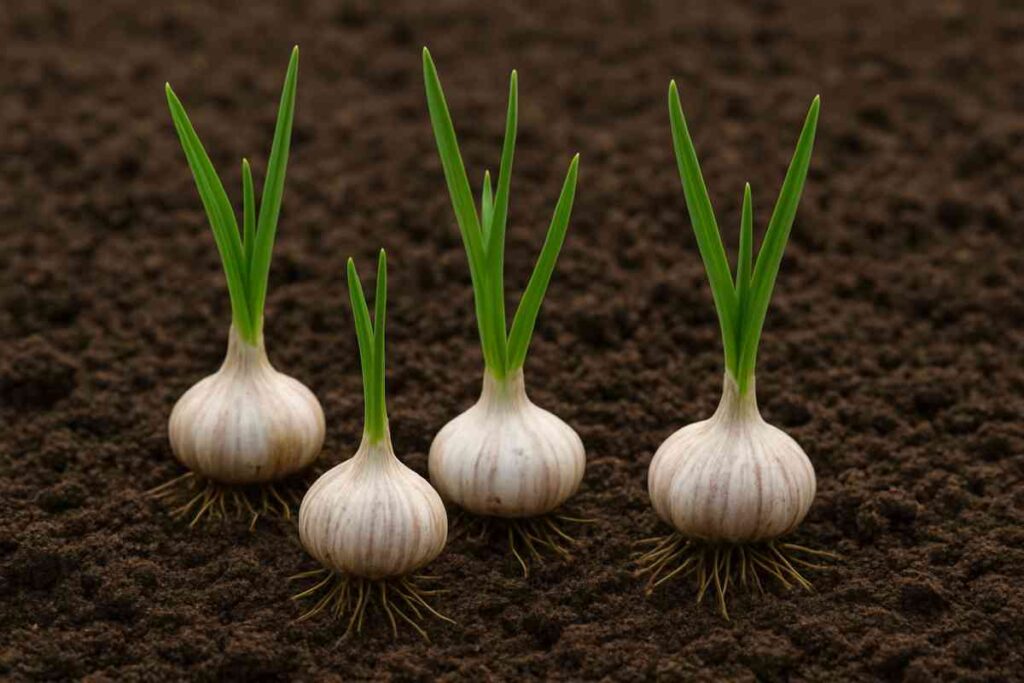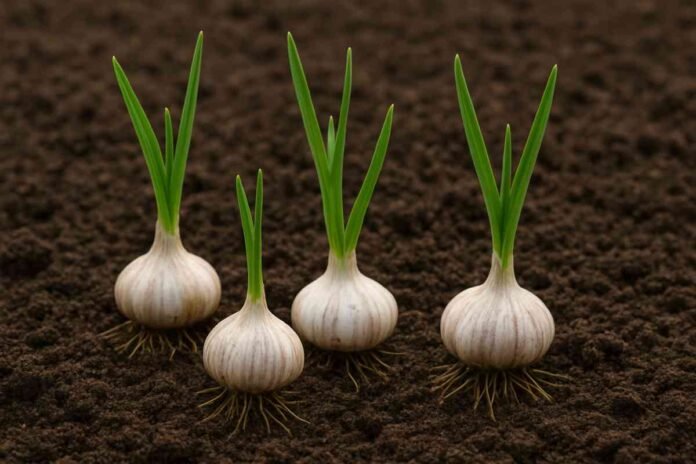Most gardeners prefer to plant garlic in fall because those 4-6 months of cold weather help the bulbs develop properly, on top of that the garlic cloves get a chance to grow strong roots before going dormant for winter.
So, if you’re planning to double harvest in summer, then fall is the right time to plant garlic bulbs.
Along with bountiful of yield, growing garlic in fall results in big bulbs.
Before dwelling further, lets now first understand growing conditions of garlic.
Growing Requirements of Garlic

Garlic thrives in moderate climates with cool winters (54-64F) and warm summers (68-100F).
It needs full sun exposure with at least 6-8 hours of direct sunlight daily for proper bulb development.
- Soil should be well-drained, loose and rich in organic matter with a pH of 6.0-6.5. Avoid heavy clay soils as they can cause bulb diseases and poor formation.
- Fall garlic planting needs to be in October or November, allowing 4-6 months of cold vernalization for proper bulb formation.
- Plant cloves 2 inches deep with 4-6 inches spacing between cloves and 6-9 inches between rows.
- Garlic plant requires consistent moisture during vegetative growth but not waterlogged conditions. Initial irrigation should be frequent (every 3 days), then reduce to weekly, and stop completely before harvest.
- This herb is a heavy feeder requiring intensive fertilization with nitrogen, phosphorus, and potassium. Apply well-decomposed organic matter at 10-20 tonnes per hectare during soil preparation.
The complete growing cycle takes 130-150 days from planting to harvest. Harvest when leaves turn yellowish and begin to dry and bend over.
Also Read: 19 Vegetables to Plant in Fall
When to Plant Garlic in Fall?
Based on your climatic conditions, start planting large garlic bulbs in September or early October.
The goal is to allow cloves to establish roots before winter without producing excessive green growth above ground.
Soil should be cool enough to prevent premature sprouting but not frozen solid. If planted too early in warm conditions, garlic may produce excessive green growth that can be damaged by winter cold.
General Rule: Plant 4-6 weeks before first hard frost regardless of zone.
How to: Planting Garlic in Fall?
Planting garlic in the fall is one of the most rewarding garden tasks. Garlic is hardy, easy to grow, and requires little maintenance once established.
By starting in autumn, you give garlic the cool period it needs to develop strong roots before winter dormancy, setting the stage for large, flavorful bulbs the following summer. Here’s a detailed step-by-step guide to planting garlic in fall.


Choosing the Right Garlic Type
Garlic comes in two main categories:
- Hardneck Garlic – Best suited for colder climates. These varieties develop a stiff central stalk (the “scape”) and typically produce larger cloves with a rich, complex flavor. Hardnecks don’t store quite as long as softnecks but thrive in areas with harsh winters.
- Softneck Garlic – More common in grocery stores, softneck varieties perform well in mild or warm climates. They produce more cloves per bulb, are easier to braid, and have an excellent storage life—often lasting up to a year.
When selecting seed garlic, avoid planting supermarket garlic, as it may be treated with chemicals to prevent sprouting. Instead, purchase certified seed garlic from a nursery or local grower to ensure disease-free, region-appropriate varieties.
Check this: 6 Low Budget Backyard Privacy Ideas for Your Landscape
Preparing the Soil
Garlic thrives in loose, fertile, and well-drained soil. Since it’s a heavy feeder, preparing the soil properly makes a huge difference in bulb size.
- Test and Amend – Aim for a soil pH between 6.0 and 7.0. If your soil is too acidic, add garden lime; if too alkaline, amend with compost.
- Add Organic Matter – Mix in well-rotted compost or aged manure before planting. This adds nutrients and improves soil texture.
- Ensure Drainage – Garlic hates soggy soil. Raised beds or ridged rows are helpful in areas with heavy clay. Loose soil lets the bulbs expand fully without deforming.
Think of this step as laying the foundation—healthy soil equals healthy garlic.
Check this: How to: Planting Broccoli in Fall?
Breaking and Selecting Cloves
When you’re ready to plant, carefully break apart the garlic bulb into individual cloves. Handle them gently to avoid bruising.
- Choose the biggest cloves – These grow into the largest bulbs.
- Leave the papery skins on – They act as a natural protective covering.
- Avoid damaged or undersized cloves – They often result in weak plants and small bulbs.
A single bulb can yield 6–12 cloves, and each clove planted will produce a new bulb at harvest.
Planting Garlic Cloves
Planting depth and spacing are critical for strong growth:
- Depth – Place each clove 2–3 inches deep in the soil. Too shallow, and they risk frost damage; too deep, and growth slows.
- Orientation – Always plant with the pointed side facing up and the flat, root end facing down. Planting upside down leads to poor development.
- Spacing – Space cloves 4–6 inches apart within the row, and keep rows about 10–12 inches apart. This gives each plant enough space for bulb expansion.
Once planted, gently pat down the soil to eliminate air pockets.
Mulching for Protection
Mulching is one of the most important steps in fall garlic planting.
Mulch insulates the cloves during winter, suppresses weeds, prevents soil erosion, and helps retain moisture.
- Best Materials – Straw, shredded leaves, or grass clippings work well. Avoid thick layers of heavy materials that can mat down and smother shoots.
- Thickness – Apply 2–4 inches of mulch. In very cold regions, go heavier—up to 6 inches for extra insulation.
As spring arrives, shoots will push through the mulch naturally.
Watering Needs
After planting, water the bed thoroughly to settle the soil around the cloves. Garlic needs consistent moisture for root establishment before winter.
- Fall – Keep the soil lightly moist until the ground begins to freeze.
- Winter – In most regions, you won’t need to water while the ground is frozen.
- Spring – Resume regular watering when new growth emerges. Garlic likes about 1 inch of water per week from rainfall or irrigation.
Avoid waterlogging, as soggy soil promotes rot.
Also Read: 18 Herbs to Plant in Fall: Grow Now
Fertilizing in Early Spring
As soon as garlic begins vigorous growth in spring, it benefits from a boost of nutrients.
- Nitrogen is the most important at this stage, as it fuels leafy top growth, which in turn supports large bulb development.
- Apply a side-dressing of compost, fish emulsion, or blood meal around the base of the plants.
- Fertilize again every 3–4 weeks until bulbs begin swelling in late spring, then reduce feeding to avoid overly leafy growth.
Proper feeding ensures plump, flavorful bulbs at harvest.
How to Care for Garlic in Fall?
After planting your garlic cloves, give them a gentle but thorough watering to help settle the soil around them. Keep the soil consistently moist (but not soggy) until the ground freezes, as this helps the roots get established before winter hits.
Once temperatures start dropping consistently, spread a thick layer of organic mulch like straw or chopped leaves over your garlic bed – about 4-6 inches deep works well.
This acts like a cozy blanket, insulating the soil and preventing those nasty freeze-thaw cycles that can push your cloves right out of the ground.
Keep an eye out for weeds trying to sneak in and steal nutrients from your garlic. Hand pulling is better than hoeing since you don’t want to accidentally damage those developing bulbs just below the surface.
In really cold areas, you might want to pile on some extra leaves or compost for additional winter protection.
The great thing about fall garlic is that it’s pretty low-maintenance once you get it tucked in properly. The roots keep quietly growing underground while everything above ground stays dormant until spring arrives.
Just check occasionally to make sure no critters have been digging around or that water isn’t pooling anywhere, which could cause your bulbs to rot.
If you planted a bit too early and notice green shoots popping up during a warm spell, don’t panic – just make sure they’re well-mulched before the real cold hits.
Also Read: How to Dry Fresh Basil Naturally?
Conclusion
Planting garlic in fall is simple but so rewarding. With a little prep—good soil, proper spacing, and a cozy blanket of mulch—you’re setting those cloves up to grow strong through winter.
With just a bit of care now, your garlic will reward you with large, aromatic bulbs when it’s time to harvest.


Khaja Moinuddin, a computer science graduate, finds joy in gardening and homesteading. Join him on this blog as he shares his experiences in homesteading, gardening, and composting


